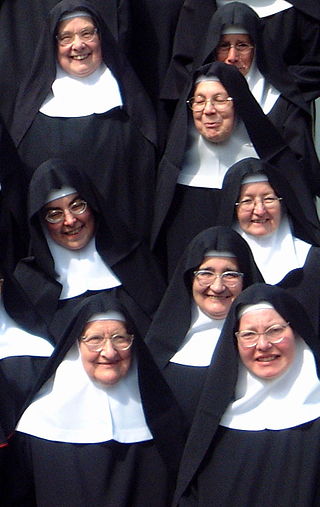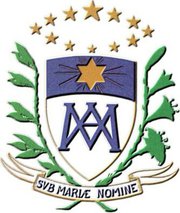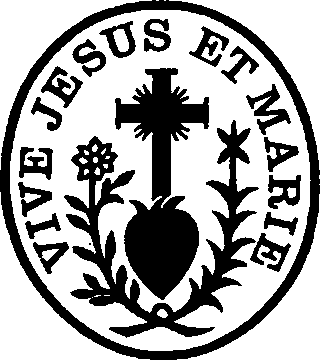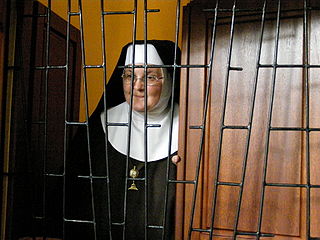Related Research Articles

The Order of Preachers, commonly known as the Dominican Order, is a Catholic mendicant order of pontifical right that was founded in France by a Castilian priest named Dominic de Guzmán. It was approved by Pope Honorius III via the papal bull Religiosam vitam on 22 December 1216. Members of the order, who are referred to as Dominicans, generally display the letters OP after their names, standing for Ordinis Praedicatorum, meaning 'of the Order of Preachers'. Membership in the order includes friars, nuns, active sisters, and lay or secular Dominicans. More recently, there have been a growing number of associates of the religious sisters who are unrelated to the tertiaries.

A nun is a woman who vows to dedicate her life to religious service and contemplation, typically living under vows of poverty, chastity, and obedience in the enclosure of a monastery or convent. The term is often used interchangeably with religious sisters who do take simple vows but live an active vocation of prayer and charitable work.

The Congregation of Holy Cross, abbreviated CSC, is a Catholic clerical religious congregation of pontifical right for men founded in 1837 by Basil Moreau, in Le Mans, France.
A canoness is a member of a religious community of women, historically a stable community dedicated to the celebration of the Liturgy of the Hours in a particular church. The name corresponds to a canon, the male equivalent, and both roles share a common historical origin. As with the canons, there are two types: canonesses regular, who follow the Rule of St Augustine, and secular canonesses, who follow no monastic rule of life.

Consecrated life is a state of life in the Catholic Church lived by those faithful who are called to follow Jesus Christ in a more exacting way. It includes those in institutes of consecrated life, societies of apostolic life, as well as those living as hermits or consecrated virgins.

The Society of Mary, better known under the name Marist, is a religious congregation under pontifical right.

There are a number of Roman Catholic religious orders or congregations with Immaculate Conception in their name. Several of them are discussed here.
A society of apostolic life is a group of men or women within the Catholic Church who have come together for a specific purpose and live fraternally. It is regarded as a form of consecrated life.

Jean-Pierre Ricard is a French prelate of the Catholic Church who was Archbishop of Bordeaux from 2001 to 2019. He has been a cardinal since 2006. He was previously Bishop of Montpellier for five years and before that an auxiliary bishop in Grenoble. From 2001 to 2007 he was president of the French Episcopal Conference.

The Congregation of Jesus and Mary, abbreviated CIM or (CJM) also known as the Eudists, is a society of apostolic life of Pontifical Right for men in the Catholic Church. It was established on March 25, 1643 by Saint Fr. John Eudes, C.I.M.
The Third Order of Saint Francis is a third order in the Franciscan tradition of Christianity, founded by the medieval Italian Catholic friar Francis of Assisi.

Enclosed religious orders are religious orders whose members strictly separate themselves from the affairs of the external world. The term cloistered is synonymous with enclosed. In the Catholic Church, enclosure is regulated by the code of canon law, either the Latin code or the Oriental code, and also by the constitutions of the specific order. It is practised with a variety of customs according to the nature and charism of the community in question. This separation may involve physical barriers such as walls and grilles, with entry restricted for other people and certain areas exclusively permitted to the members of the convent. Outsiders may only temporarily enter this area under certain conditions. The intended purpose for such enclosure is to prevent distraction from prayer and the religious life and to keep an atmosphere of silence.
The Sisters of the Holy Family is the name for several different religious institutes of women in the Catholic Church:

The Institute of the Good Shepherd is a Catholic society of apostolic life made up of traditionalist priests promoting the Tridentine Mass and other traditional sacraments, in full communion with the Holy See. As of 2024, the Institute has 62 priests, 5 deacons and 44 seminarians and is active in ten countries over four continents.

The Saint John Family is a religious order composed of three French Catholic congregations: the Brothers of Saint John, the Apostolic Sisters of Saint John, and the Contemplative sisters of Saint John. It also comprises oblates.
A Religious Brother is a lay member of a religious institute or religious order who commits himself to following Christ in consecrated life of the Church, usually by the vows of poverty, chastity and obedience. Equivalent to a Religious Sister, he usually lives in a religious community and works in a ministry appropriate to his capabilities.
In the Catholic Church, a religious institute is "a society in which members, according to proper law, pronounce public vows, either perpetual or temporary which are to be renewed, however, when the period of time has elapsed, and lead a life of brothers or sisters in common."

A religious sister in the Catholic Church is a woman who has taken public vows in a religious institute dedicated to apostolic works, as distinguished from a nun who lives a cloistered monastic life dedicated to prayer and labor, or a canoness regular, who provides a service to the world, either teaching or nursing, within the confines of the monastery. Nuns, religious sisters and canonesses all use the term "Sister" as a form of address.
Pierre-Justin Delort, often anglicized to Peter, was a French priest and academic who was exiled following the French Revolution and moved to Ireland. Born in Bordeaux in December 1748. A priest in the Archdiocese of Bordeaux in France, he held a Doctor of Laws from the University of Bordeaux. Delort was a professor of philosophy at the Collège de Guyenne, before the Revolution. Following the revolution, he emigrated to London.
References
- 1 2 "Holy Family of Bordeaux", Service des moniales
- ↑ "Sisters of the Holy Family of Bordeaux", OMI
- 1 2 "Our Founder", Casa Generalizia Santa Famiglia di Bordeaux
- ↑ "A Blue Plaque in recognition of the Sisters of the Holy Family of Bordeaux", Tameside Tourist Information Centre
- ↑ "About Us". Holy Family of Bordeaux in Great Britain and Ireland.